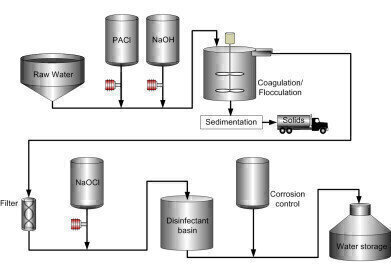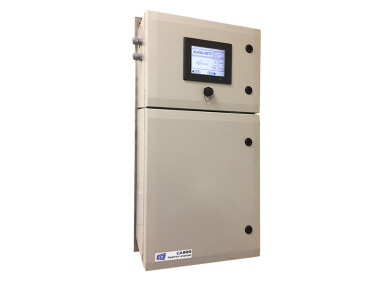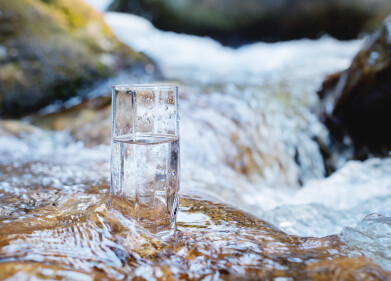Water/Wastewater
Process Refractometer brings Real-Time Process Control to Pure Water Treatment by Chemical Precipitation
May 03 2013
The K-Patents Process Refractometer determines the concentration of dissolved solids by making an optical measurement of a solution's refractive index and it is the most accurate, reliable and easy-to use in-line instrument for liquid concentrations that the company has developed to date. K-Patents (Finland) has built a reputation for in-line liquid concentration measurements within the process industries worldwide. K-Patents’ refractometer is a reliable and accurate instrument with a wide area of applicability, for instance in pure water treatment by chemical precipitation.
Polyaluminium coagulants are finding increasing use in potable water treatment plants, particularly, for soft, coloured surface waters. Water treatment by chemical precipitation starts with adding flocculants, specifically, Polyaluminium Chloride (PACl) and Sodium Hydroxide (NaOH) into raw water. PACl is a synthetic polymer dissolved in water. It precipitates in big volumetric flocs which absorb suspended pollutants in the raw water. The amount of Polyaluminium Chloride to be added to the process is defined with regard to the turbidity of the raw water. In order to keep the flocculation process smooth, PACl concentration must controlled to be higher than 10 %. When in the storage tank, Polyaluminium Chloride is stable, but it tends to crystallise after a period of time. K-Patents’ refractometer allows for monitoring of PACl, informs about the necessity for the tank or pipe cleaning, and thus prevents them from blocking with the PACl crystals.
NaOH regulates pH level, increases alkalinity and neutralises acids in the water. In alkaline water coagulation and flocculation processes work more effectively. Moreover, sufficient alkalinity prevents lead dissolving from lead pipes and pipe fittings, as well as reduces the corrosiveness of water to iron pipes.
Further, particles suspended in water start precipitating and combining into larger particles, i.e. flocs. The flocs are then settled at the bottom in the form of sludge. The sediment is removed from the process. After separating most floc the water proceeds for filtering where remaining suspended particles and unsettled floc are removed.
In the filtration phase the water goes through the layers of anthracite, sand and gravel. Organic compounds contributing to taste and odour are removed. Other remaining particles are trapped by adhering to the sand and gravel particles.
After harmful micro-organisms have been filtered, it is necessary to add disinfecting chemicals to the water in order to inactivate pathogens and potentially harmful micro-organisms. When dissolved in water, Sodium Hypochlorite (NaOCl) releases chlorine. It is an efficient and safe disinfectant if added in a sufficient amount. Fluoride may also be added to the water with the goal of reducing tooth decay and preventing chronic diseases. However, Fluoride in the water must not exceed recommended levels. Excessive levels of fluoride can be toxic or cause staining of teeth. Apart from sodium hypochlorite, liquid chlorine and chlorine dioxide may also be used as disinfection reagents.
Sodium Hypochlorite is unstable and easily decomposes. The stability of NaOCl solution is dependent on the following factors: hypochlorite concentration, temperature of the solution, pH value of the solution, concentration of the impurities catalysing decomposition, and exposure to light. With K-Patents refractometer it is possible to monitor NaOCl concentration and control the disinfection conditions.
The water purification disinfection stage is accomplished in the disinfectant basin. In order to assure high quality of the purified water corrosion control is performed. Finally, the pure water is stored for further consumption.
K-Patents Teflon Body Refractometer PR-23-M provides real-time in-line measurements of Polyaluminium Chloride and Sodium Hydroxide at the initial stage of the purification process, insuring efficient flocculation of undesired particles. By measuring Sodium Hypochlorite and Fluoride at the water disinfection stage high quality of the purified water at the outlet is assured.
The installation point of the K-Patents’ three refractometers is in a by-pass loop between the storage tank pump outlet and the treatment point. The refractometer sensor allows monitoring of the chemicals concentration at the exit from the storage tank to the pipe treatment point.
Digital Edition
AET 28.2 April/May 2024
May 2024
Business News - Teledyne Marine expands with the acquisition of Valeport - Signal partners with gas analysis experts in Korea Air Monitoring - Continuous Fine Particulate Emission Monitor...
View all digital editions
Events
Jul 10 2024 Birmingham, UK
Jul 21 2024 Cape Town, South Africa
Australasian Waste & Recycling Expo
Jul 24 2024 Sydney, Australia
Jul 30 2024 Jakarta, Indonesia
China Energy Summit & Exhibition
Jul 31 2024 Beijing, China


















